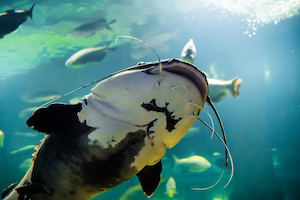
Redtail Catfish
Scientific name: Phractocephalus hemioliopterus
The Redtail Catfish is a large and impressive freshwater fish native to the Amazon, Orinoco, and Essequibo river basins in South America.
IUCN Red List of Threatened Species : Not Evaluated
Recognized by its olive to dark gray body, white underside, and distinctive bright red tail, this catfish is a popular species among experienced aquarists with the space and resources to accommodate its substantial size.
The Redtail Catfish is valued for its striking appearance and vigorous personality but requires significant commitment due to its rapid growth and long lifespan.

Navite Location
Amazon, Orinoco, and Essequibo river basins, including countries like Brazil, Venezuela, Peru, and Colombia
Varieties
Crossbreeds like the Tiger Redtail (Redtail Catfish × Tiger Shovelnose Catfish) exist but are not natural varieties.
Suggested Tank Mates
Large, robust fish that are too big to be considered prey / Arapaima / Arowana / Pacu / Other large catfish species (e.g., Shovelnose Catfish) / Note: Compatibility is not guaranteed; monitoring is essential
Tank Mates to Avoid
Small to medium-sized fish (will be seen as food) / Slow-moving or docile fish / Fish that cannot tolerate aggressive or territorial behavior / Crustaceans and amphibians (will likely be eaten)
Diet
Live or frozen fish / Shrimp, prawns, and mussels / Worms and insects / High-quality sinking pellets
Breeding
Breeding Redtail Catfish in captivity is extremely rare and not well-documented due to their size and specific environmental requirements.
Lifespan
15 to 20 years or more with proper care
Size
Up to 1.8 meters (6 feet) in length in the wild / In captivity, commonly reach 90 to 120 cm (3 to 4 feet)
Minimum Tank Size
At least 1,000 gallons (3,785 liters) for juveniles / Adults require ponds or custom-built tanks exceeding 10,000 gallons (37,850 liters)
Optimum Tank Temperature
22°C to 28°C (72°F to 82°F)
Ideal pH Level
6.0 to 7.5
Water Hardness
2 – 15 dGH
Common Health Issues
Poor Water Quality-Related Illnesses / Parasitic Infections / Bacterial Infections / Physical Injuries / Stress due to inappropriate tank conditions
Interesting facts
Rapid Growth
Redtail Catfish grow very quickly, often reaching over 60 cm (2 feet) within the first year.
Whisker Sensitivity
Their barbels are highly sensitive and help them navigate and locate food in murky waters.
Longevity
With proper care, they can live for two decades or more, representing a significant long-term commitment.
Cultural Significance
In their native regions, they are both a food source and a sport fish due to their size and strength.
Not Suitable for Most Aquariums
Despite being sold as juveniles, their adult size makes them impractical for most home aquariums.
Redtail Catfish FAQ’s
Can I Keep a Redtail Catfish in a Home Aquarium?
Typically, no. While juvenile Redtail Catfish may fit in a large home aquarium initially, they quickly outgrow standard tanks. Due to their potential to grow over 1 meter (3 feet) long, they require exceptionally large tanks or ponds. They are best kept by public aquariums or in private ponds designed to accommodate their size.
How Fast Do Redtail Catfish Grow?
Redtail Catfish are known for their rapid growth rate. They can reach 60 cm (2 feet) within the first year if provided with ample space and proper nutrition. This rapid growth necessitates planning for adequate housing from the outset.
What Do Redtail Catfish Eat?
They are opportunistic carnivores that consume a variety of foods. In captivity, they can be fed a diet of high-quality sinking pellets, supplemented with pieces of fish, shrimp, mussels, and other meaty foods. Feeding live feeder fish is discouraged due to the risk of disease transmission.
Are Redtail Catfish Aggressive?
Redtail Catfish are not typically aggressive toward fish they do not consider food. However, due to their large size and predatory nature, they will consume any tank mates small enough to fit into their mouths.
Caution is advised when selecting tank mates.
Can Redtail Catfish Live with Other Fish?
They can coexist with other large, robust fish in sufficiently spacious environments. Tank mates should be of similar size and able to tolerate similar water conditions. Close monitoring is necessary to ensure compatibility.
What Tank Size Is Required for a Redtail Catfish?
A single adult Redtail Catfish requires a tank or pond of at least 10,000 gallons (37,850 liters). This size accommodates their large size and active swimming behavior.
Most standard aquariums are insufficient.
How Long Do Redtail Catfish Live?
With proper care, Redtail Catfish can live 15 to 20 years or more. They represent a significant long-term commitment and require consistent, high-quality care throughout their lives.
Are Redtail Catfish Suitable for Beginners?
Due to their size, dietary needs, and space requirements, Redtail Catfish are not suitable for beginner aquarists. They are best cared for by experienced hobbyists or professionals with the resources to meet their needs.
